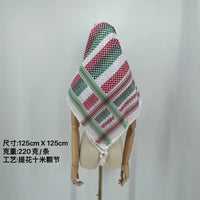How to Tie Your Hatta | Keffiyeh | Shemagh in Petra, Jordan: A Timeless Tradition
The traditional head coverings in Jordan, often referred to as the hatta, keffiyeh, or shemagh, are not just an accessory; they carry centuries of cultural significance and practical use. As you stroll through Petra, with its majestic rock-cut architecture and timeless desert landscapes, you’ll notice many locals, including Bedouins and visitors alike, donning these distinctive head coverings. Let’s dive into the art of tying and wearing this piece of history, just like the kings, tribal leaders, and villagers have done for generations.
What is a Hatta | Keffiyeh | Shemagh?
The hatta (or keffiyeh in some regions) is a square piece of fabric, traditionally made of cotton or wool, folded into a triangle and worn on the head. It’s more than just a fashion statement; it has been an essential tool for protection from the elements, such as the scorching sun, biting wind, and swirling sandstorms of the desert. While the fabric may be simple, its significance runs deep, with different colors and patterns symbolizing regional affiliations and tribal identities.
In Petra, the keffiyeh is often worn in a vibrant red-and-white pattern, echoing the Jordanian tradition, while the black-and-white variant is common in Palestine. The plain white version, held in place by a black band (agal), is favored in the Arabian Peninsula. Each color and style tells a story of heritage and belonging.
How to Tie Your Hatta Like a Local
Tying a hatta may seem complex at first, but with a little practice, you can master the art and wear it with ease during your visit to Petra. Here’s a step-by-step guide to tying your hatta or keffiyeh like the Bedouins and kings of Jordan:
-
Fold the Square into a Triangle
Start with the hatta flat and fold it diagonally so that it forms a large triangle. This is the basic shape you’ll need to begin styling it. -
Place the Triangle on Your Head
Drape the triangle over your head with the fold resting across your forehead. Let the two ends of the triangle hang over your shoulders, while the point of the triangle drapes down your back. -
Adjust the Black Band (Agal)
To hold the hatta in place, Bedouins and Arabs often use a black cord called the agal. Carefully place the agal over your head, securing the hatta so that it stays in position without slipping. The agal has its own cultural significance and, in some traditions, was a signal for young men ready for marriage. -
Style the Ends
Now, you can choose how to wear the ends of the hatta. One common style, worn by tribal leaders and kings like King Hussein of Jordan, is to leave the ends draped over the shoulders, creating an elegant and dignified look. Another popular style is to toss one end behind the shoulder, while leaving the other loose at the front, adding a touch of practicality for a casual yet regal appearance. -
Practical Style for Desert Adventures
When trekking through Petra’s dusty pathways, you may need to shield your face from the sand or the sun. Wrap one of the ends around your mouth and nose, securing it at the back of your head. This not only protects your face but also serves as an efficient filter against sandstorms, much like how Bedouins have survived desert winds for centuries. -
Tie It for Work
If you plan on getting hands-on, whether helping with a task or joining a local festival, there’s another style to consider. Cross the ends of the hatta at the back of your neck and bring them forward, tying them in a loose knot. This keeps the headscarf firmly in place while allowing you to move freely, just like the villagers do during harvest time. Traditionally, this style was worn by men during agricultural activities to ensure their hatta stayed secure.
A Symbol of Heritage
The hatta or keffiyeh isn't just a functional item—it's deeply intertwined with the Jordanian identity and way of life. From the young men signaling their readiness for marriage by slightly shifting the agal, to the older generations protecting themselves from the harsh elements of the desert, each twist and fold of the hatta tells a story. And when you wear it in Petra, you’re not only protecting yourself from the elements but also carrying on a centuries-old tradition.
Whether you’re a visitor exploring the ancient wonders of Petra or a local steeped in Jordanian culture, wearing the hatta ties you to the timeless heritage of the desert people. As you walk through Petra's narrow passageways and stand in awe of the towering Treasury, know that your hatta connects you to the kings, tribes, and villagers who have walked this land before you.






